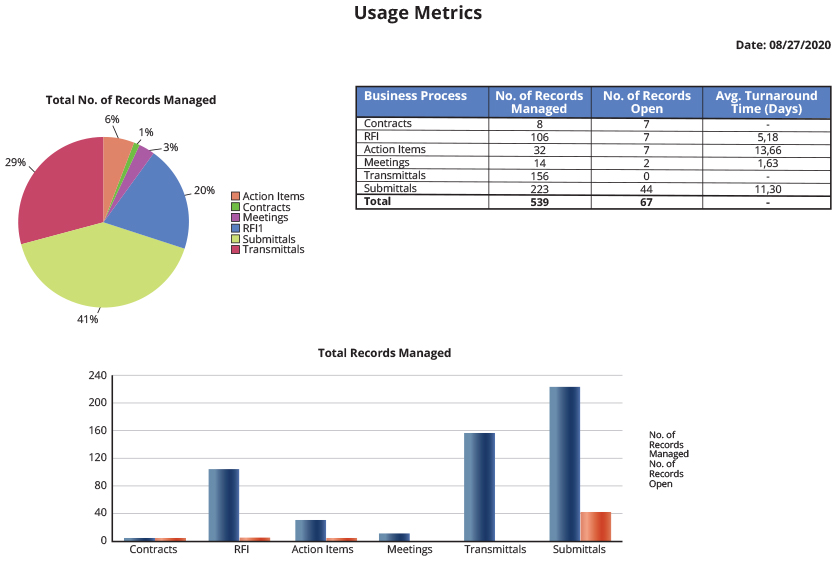Achieving increased project alignment and finding actionable intel by implementing a project management office.
As historically resolute industries continue to navigate how to stay productive during these uncertain times, and the workforce charts new territories in further blurring the lines between work and home, remote project management will continue to be vital for organizations and the communities they serve. Utilities nationwide have a responsibility to keep advancing critical projects — even when key personnel are unable to be in the office or field — to support the safe and reliable infrastructure that will help our country move forward.
Project management office (PMO) provides the insight needed to create a more efficient project life cycle by not only identifying challenges but providing proven solutions. By applying the forward-thinking principles of a PMO, technology and processes can be aligned and improved to optimize project delivery and help maintain business continuity.
Sustained success through intuitive implementation
The road to successful PMO adoption and utilization begins with effective implementation. While there are many different models and types of PMOs, the shared intention of each is to improve project performance by standardizing processes and facilitating the sharing of tools and techniques that drive efficiency.
When mapping out the right PMO that will support long-term project management excellence, utilities should focus on people, processes and technologies.
People
Creating effective change in any organization begins with support from the top. A successful utility PMO is supported at the highest level to both champion and direct the establishment of new internal functions.
With executive buy-in and expectations established, a PMO then defines and builds the project team by recruiting people with the necessary experience levels. Whether consisting of project managers, subject matter experts or business personnel, this group has clarity of purpose and understands how a PMO can bring value to a utility.
Firms with experience in utility PMO setup can fast-track progress and train internal staff for highly effective, long-term project management roles.
Processes
Using a consistent lens to plan and execute projects saves utilities time and money by increasing efficiency and reducing risk. A consistent approach is only possible by defining overarching objectives and creating clearly defined processes that will support the success of these goals.
By nature, utility projects consist of an almost unlimited number of variables. The creation of and adherence to PMO processes supports consistent decision-making and helps define project elements, from data gathering and resource tracking to budget monitoring and project team training. The result: consistency, a hallmark of excellent project management.
Evaluating existing processes and assessing areas of past project performance can help identify what methods can be used, what aspects need to be modified and where new procedures are required.
Technologies
With the proper team established, goals set and processes defined, a utility PMO is prepared to evaluate the tools and technologies needed for execution. The toolset used by a PMO helps to drive process accountability and further increase efficiency.
Utilities should begin by explicitly defining what the criteria are for software and technology tools to support the processes developed by the PMO. Requirements for technology options will be driven by the vision for the PMO, stakeholder roles and needs, and will be used to enforce the defined processes.
Pathways to proactive project management
With the right technology applications in place, utilities can continue operating, managing projects, and communicating efficiently and effectively with their teams, clients and vendors.
While utilizing online collaboration tools such as Microsoft Teams or Zoom is a valuable first step, remote project monitoring requires the technical capabilities of more sophisticated software. Technology can be empowering, but without effective business governance and a strategic framework, it can become an encumbrance just as easily.
The following project management applications can help utilities stay abreast of project progress and continue moving projects forward:
- Project and construction management: In the current environment, a web-based platform for managing project and construction data is crucial. Project and construction management tools provide a variety of project-related functions and allow clients to access timely information in a central repository. These software supports cost management and offers features that enhance communication among project stakeholders, including requests for information modules, change control, submittal management and invoicing. (Examples in this category: Primavera Unifier, ProCore, Ares Prism, Hexagon EcoSys.)
- Document management: Successful remote project monitoring depends on efficient information sharing. This requires all project team members to be engaged on one platform that supports all file types without file size limits. Organizations are increasingly migrating document management to cloud collaboration platforms, and the pandemic has only hastened this trend. It provides project-wide visibility and control among the many different entities collaborating on a project. Internal and external team members alike can access project data regardless of whether they are in the construction trailer or their living room. (Examples in this category: Oracle Aconex, OpenText, HxGN SDx.)
- Portfolio management: Proper front-end project development increases the chances of project success during execution. A portfolio management tool facilitates this process by tracking projects and advancing them through stage gates as they meet requirements. Capital program scenario planning can be especially powerful when projects may need to be shuffled around to accommodate a dynamic environ¬ment. Using a portfolio management tool, teams can run scenarios to optimize a portfolio with changing conditions and criteria, advance the business process and projects through online stage-gate approval, add or remove items from the budget and authorize proj¬ect execution digitally. (Examples in this category: Primavera Cloud, Hexagon EcoSys Portfolio)
- Dashboard reporting: A business analytics tool that provides configurable, role-based dashboard report¬ing is also important. Microsoft Power BI provides dependable data with decreased report assembly time and minimal human errors. Regardless of which backbone project management platform you use, Power BI can be configured to aggregate data from various databases, tables and spreadsheets through integration or data staging.
- Schedule management: Remote project scheduling keeps projects moving regardless of where you are. Oracle Primavera P6 Enterprise hosts live project schedules, cash flow-related data and performance measurement baselines. Activities are grouped by work breakdown structures or contracts so the groups responsible for the work can provide updates remotely and reliably. Critical path method schedul¬ing also allows teams to identify bottlenecks in the projects to pay attention to. What-if scenarios can be run to assess impact of disruptions on schedule. P6 can also provide schedule and project status report¬ing. It also has the ability to migrate your desktop schedules to a cloud-based P6 platform.
These latest technologies can help project teams stay connected with colleagues, clients and vendors. The implementation and integration of these applications with an enterprise system allow you to scale up or down to meet your unique project needs, facilitating a seamless transition to remote project monitoring.
Putting the pieces together
Organizations typically face a common set of challenges: prioritizing their projects, then executing them within budget and on schedule. This requires juggling budgets, resources, schedules, contracts and communications across teams — and often across multiple technology platforms. Undoubtedly, these struggles are exacerbated in the current environment.
The route from strategy to customized solution follows a simple, yet vital, path through four basic steps: organizational assessment, business process design, technology consulting and implementation and continuous improvement.
Step 1: Organizational assessment. Before improving your business practices, you must first intimately understand them. Organizational assessments comprise a holistic review of current project management strategies, an inventory of current software and tools, and an assessment of the organization’s appetite for change.
Through a combination of interviews with leadership and other professionals, as well as an in-depth review of existing information, a picture emerges of the current state of the organization. After performing this comprehensive audit, only then can new initiatives be identified and implemented to bridge the gap between current and future efforts and achieve the necessary employee adoption of enterprise-wide changes.
Step 2: Business process design. Sound business processes streamline workflow, reduce unproductive work, align objectives and optimize resource utilization. The process design stage homes in on determining the right blend of management systems to organize and capitalize upon existing processes while also supplementing where needed.
Bringing in an end-to-end delivery perspective — from planning and engineering to construction, coupled with industry-specific experience — can facilitate tailored, streamlined solutions that integrate business processes across an organization. The result is a creative and efficient project management framework, which draws on stakeholder ingenuity at the right time to facilitate a paradigm shift from reactive administration of tasks to allowing project managers to focus on proactive management of risks and uncertainties.
Step 3: Technology implementation. Your business systems and software provide the tools and information you need for daily operations. Specialized systems may be necessary for different components of your business, accompanied by significant investment in the systems, staffing and training.
The true differentiator for enterprise project management is the integration of software within your governance process. The strategies developed in earlier stages will help dictate how processes and systems — whether on-site or in the cloud — can be coordinated to facilitate the smooth flow of data.
Step 4: Continuous improvement. Implementing PMO principles is a good start toward enhanced efficiency and improved project management. To thrive in an evolving market, organizations must commit to continuing to innovate and embrace change. Data analytics can help you identify areas that could be strengthened — data’s value is greater when it is successfully interpreted to drive actions that enhance performance.
Key performance indicators (KPIs) collected and analyzed during the PMO process should continuously inform business decisions by incorporating real-world observations and calibrating approaches to optimize outcomes. With a tailored combination of data collection, visualization and assessment, the prioritization and gaining of efficiencies are made easier, more successful and more productive when filtered through iterative improvements.
Progressing toward an integrated future
Now more than ever, infrastructure and investment projects must be efficient, on time and add value for utilities and their communities alike. With leadership commitment to a PMO in place, utilities can move on to establishing the right team, defining overarching goals and developing effective processes. These critical elements help utilities succeed in creating an effective PMO, ultimately driving longer-term project management success.
 Clarice Kinsella is a senior project manager and PMO business unit manager for Burns & McDonnell with almost 20 years of experience in the power industry. She leads development and execution of large-scale fossil fuel and renewable energy projects and consults with clients on capital projects management and delivery.
Clarice Kinsella is a senior project manager and PMO business unit manager for Burns & McDonnell with almost 20 years of experience in the power industry. She leads development and execution of large-scale fossil fuel and renewable energy projects and consults with clients on capital projects management and delivery.









